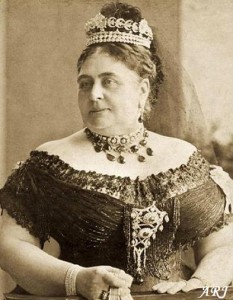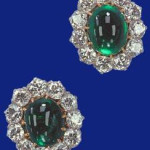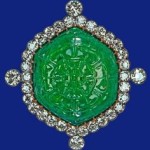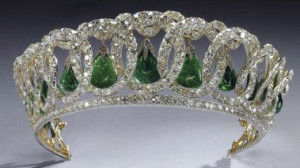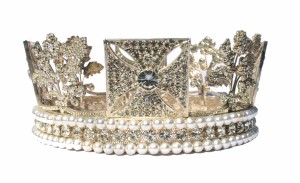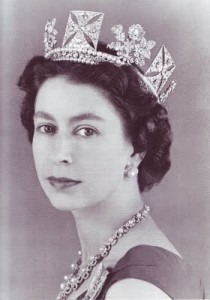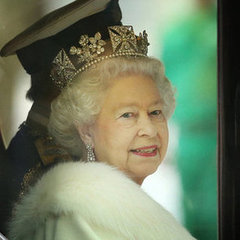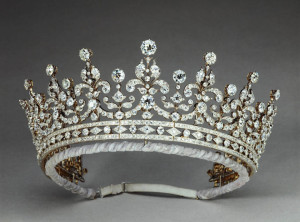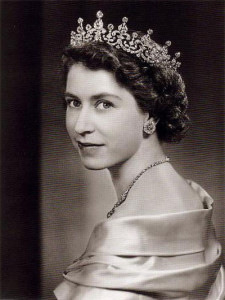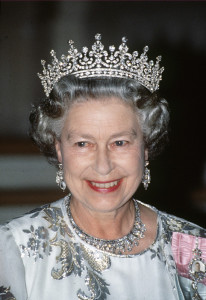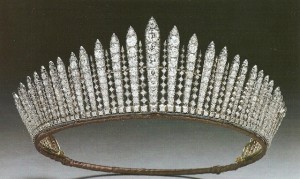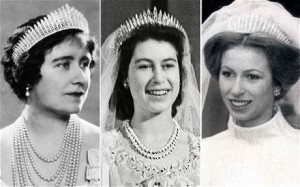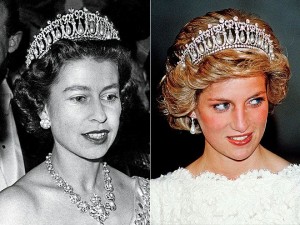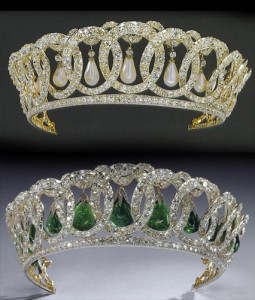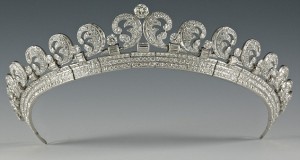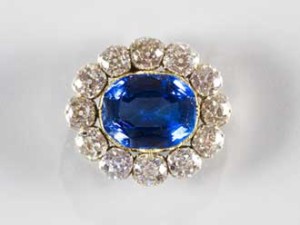The Cambridge Emeralds came into the royal family through Queen Mary who was the grandmother of the current queen, Queen Elizabeth II. The story is a very interesting one in which the emeralds were originally acquired by Augusta of Hesse- Kassel, the Duchess of Cambridge (Queen Mary’s grandmother) in 1818 at a charity lottery while they were in Frankfort, Germany. The box that was the prize is said to have contained somewhere between 30 to 40 cabochon emeralds (cabochon is a French word meaning a gemstone which is slightly shaped and polished as opposed to being cut and faceted).
The Duchess had some of the emeralds set into a pair of drop earrings and a pendant necklace. After her death her daughter, Mary Adelaide, the Duchess of Teck (Queen Mary’s mother) inherited the emeralds. Unfortunately, the Cambridge emeralds were almost lost to the royal family when they were passed onto Prince Francis of Teck (Queen Mary’s brother) and when he died suddenly in 1910 the emeralds fell into the possession of his mistress. Luckily, Princess Mary of Teck (later to become Queen Mary) retrieved the emeralds under questionable circumstances.
Queen Mary was known to wear numerous pieces of jewelry at one time and on the occasion of the Imperial Durbar held in Delhi in 1911, when King George V was crowned Emperor of India, she had a majority of the Cambridge emeralds set into what became known as the Delhi Durbar parure. (A parure in royal terms is a set of matching jewelry that would sometimes include a tiara, necklace, bracelet, brooch and earrings)
Then in 1921, Queen Mary bought a diamond and pearl tiara from the Grand Duchess Elena Vladimirovna of Russia. The tiara had been smuggled out of Russia by a British diplomat during the 1917 revolution. After acquiring the tiara, Queen Mary had it altered and the original teardrop pearls could be replaced by fifteen Cambridge cabochon emeralds. (Please click on the link, the Queen’s Jewelry Collection – Part One, for additional information on the Grand Duchess Vladimr Tiara)
The remaining Cambridge emeralds were used in additional brooches, necklaces, bracelets and earrings made by Garrards, the Royal Jewelers. These pieces of jewelry were cleverly designed so that the emeralds could be detachable from their setting so that Queen Mary would be able to insert gemstones that would coordinate with the color of her gowns.
All of the jewelry mentioned; the Delhi Durbar parure, the Vladimir tiara and the additional pieces using the Cambridge emeralds, were the personal property of Queen Mary. Eventually, Queen Elizabeth II inherited the collection in 1953.
The Cambridge Emerald Collection including the Delhi Durbar Parure
The Delhi Durbar Tiara – The tiara was originally part of the Delhi Durbar Parure and was set with several of the Cambridge emeralds, many years later the ten cabochon emeralds would be eventually used in the Grand Duchess Vladimir Tiara. The Delhi Durbar Tiara is now part of Queen Elizabeth’s personal jewelry collection and was most recently worn by Camilla, the current Duchess of Cornwall.
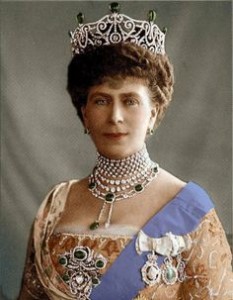
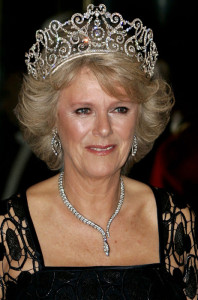
The Delhi Durbar Necklace – The Delhi Durbar Necklace was specifically made for the 1911 Delhi Durbar and is set with nine cabochon Cambridge emeralds, six large diamonds, numerous smaller diamonds and the Cullinan VII diamond which is an 8.8 carat marquise shaped diamond. The necklace was made by Garrard at the request of King George V and was presented to Queen Mary on occasion of her 44th birthday. Since the Queen Elizabeth inherited the necklace in 1953 she usually wears it paired with the Vladimir Tiara for evening events.
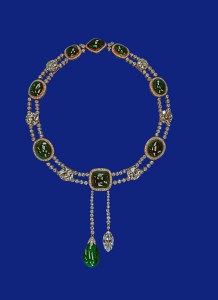
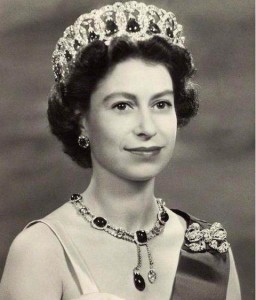
The Delhi Durbar Bracelet – The original Delhi Durbar Parure included three emerald bracelets made by Garrard and this one is set in platinum and gold with three of the Cambridge emeralds and several diamonds. Later, when Queen Elizabeth inherited the jewelry collection from her grandmother, Queen Mary, the Delhi Durbar Bracelet was one of her favorite pieces and she often wears the bracelet for evening engagements.
The Delhi Durbar Earrings – The Delhi Durbar earrings are set with one of the Cambridge oval shaped cabochon emeralds surrounded by 11 diamonds and a matching emerald provided by Garrard surrounded by an additional 11 diamonds. Since Queen Mary would often wear several necklaces at one time, the earrings were kept relatively simple in style.
The Delhi Durbar Stomacher and Scroll Cambridge Emerald Brooch – These pieces of jewelry were specially made by Garrard for Queen Mary to wear to the 1911 Delhi Durbar. The Delhi Durbar Stomacher is set in gold with seven of the Cambridge emeralds, chips from the Cullinan diamond and several smaller diamonds. The stomacher was a favorite of Queen Mary and she wore it often with several additional brooches, such as the Cullinan V Heart Brooch and the Cullinan VIII Emerald-cut Brooch, to create an impressive display. (a stomacher is customarily a set of elaborate pieces of jewelry that are normally worn over the bodice of a gown) One of those additional brooches worn with the Delhi Durbar Stomacher was the Scroll Cambridge Emerald Brooch which included a square-shaped emerald placed in a scrolled diamond setting and a removable emerald pendant. Since the Cambridge Emerald collection passed to Queen Elizabeth in 1953 she rarely wears the Stomacher but occasionally wears the Scroll Brooch for day or evening engagements.
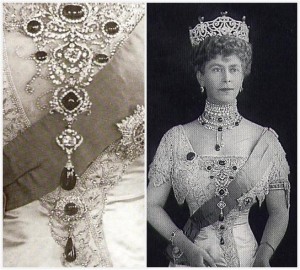
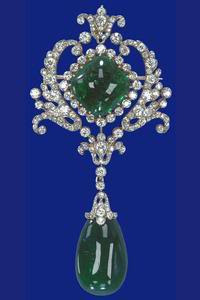
The Delhi Carved Emerald Brooch – Queen Mary was given the Delhi Carved Emerald Brooch by the ladies of India to wear at the Delhi Durbar in 1911. This brooch does not contain one of the Cambridge Emeralds but it is included in the Delhi Durbar Parure. Set in silver and gold, the large hexagon shaped emerald is intricately carved with the images a rose on the front and an unidentified plant on the back and it is surrounded by several diamonds. Queen Mary wore the brooch pinned at the top of the Delhi Durbar Stomacher with additional brooch pinned below. In 1953, the Delhi Carved Emerald Brooch was passed to Queen Elizabeth and she only wears in occasionally due to its heavy weight.
The Round Cambridge Emerald Brooch – Unlike the other pieces of Cambridge Emerald jewelry collection, this brooch was not specifically made for the Delhi Durbar although it was worn for that occasion in 1911. The round cabochon emerald is surrounded by two rows of diamonds with a pear shaped emerald pendant that can be detached. After the death of Queen Mary, the brooch was passed to Queen Elizabeth who wears it often and mostly with the pendant attached and but she will occasionally wear it without the pendant.
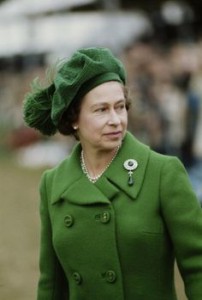
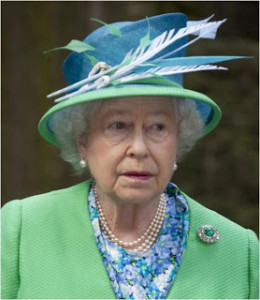
The Grand Duchess Vladimir Tiara – In 1921, Queen Mary bought a diamond and pearl tiara from the Grand Duchess Elena Vladimirovna of Russia. Queen Elizabeth inherited the tiara in 1953 and frequently wears it with the original teardrop pendants and occasionally with the interchangeable Cambridge Emerald pendants. (Please click on the following link, the Queen’s Jewelry Collection – Part Two, for additional information on the Grand Duchess Vladimr Tiara)
The Art Deco Emerald Choker – There is some controversy surrounding this Art Deco Emerald Choker and it was always believed that this necklace was created for Queen Mary with the Cambridge Emeralds for the 1911 Delhi Durbar. Recently it was determined that the emeralds used in the necklace were in fact a gift to Queen Mary from the Ladies of India and this necklace is sometimes confused with the Delhi Durbar Necklace. The confusion lies in the fact that in 1921 Queen Mary had the original necklace redesigned and shortened into an Art Deco style choker set in platinum which she worn with a multiple strands of diamond necklaces. The Art Deco choker was passed to Queen Mary in 1953 but she did not prefer the shortened style. Much later in the 1980s the Queen loaned the choker to Diana, the Princess of Wales. Diana wore the choker often and it became one of her signature pieces of jewelry. Then in 1985 on a tour of Australia she wore the chocker in a very unusual way. At an evening engagement in Melbourne Diana cleverly accessorized her beautiful turquoise Emanuel designed evening gown by wearing the chocker as a bandeau in a distinctive 1920 style across her forehead. Upon Diana’s death in 1997 the necklace was returned to the Queen.
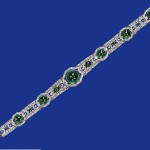
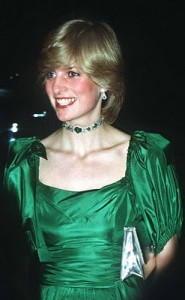
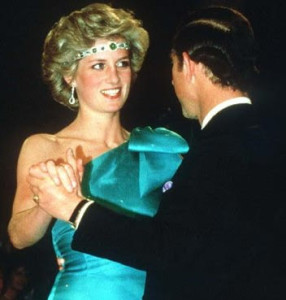
Also, if you are interested in more information about the Royal Family and their jewels, please click on the links to the following posts: The Crown Jewels (Part One and Part Two) and the Queen’s Jewelry Collection (Part One and Part Two)

